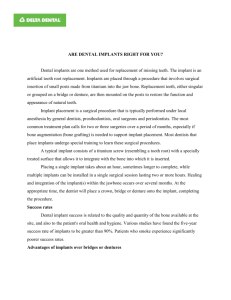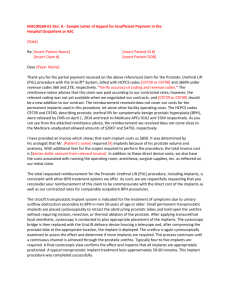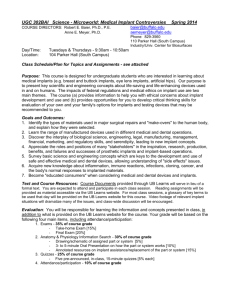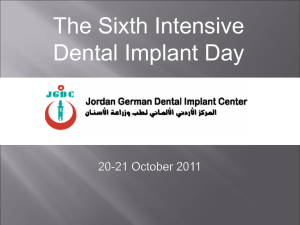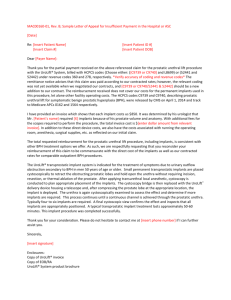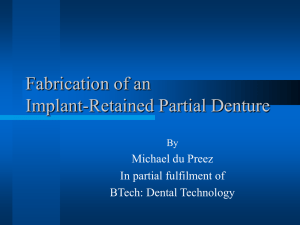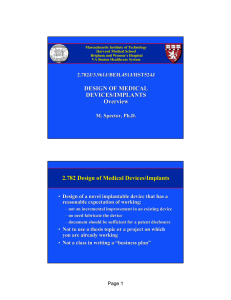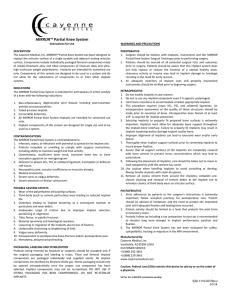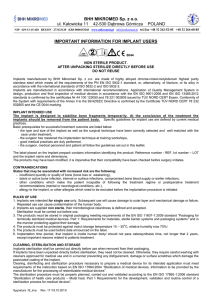Diagnosis and treatment of periimplant infections
advertisement
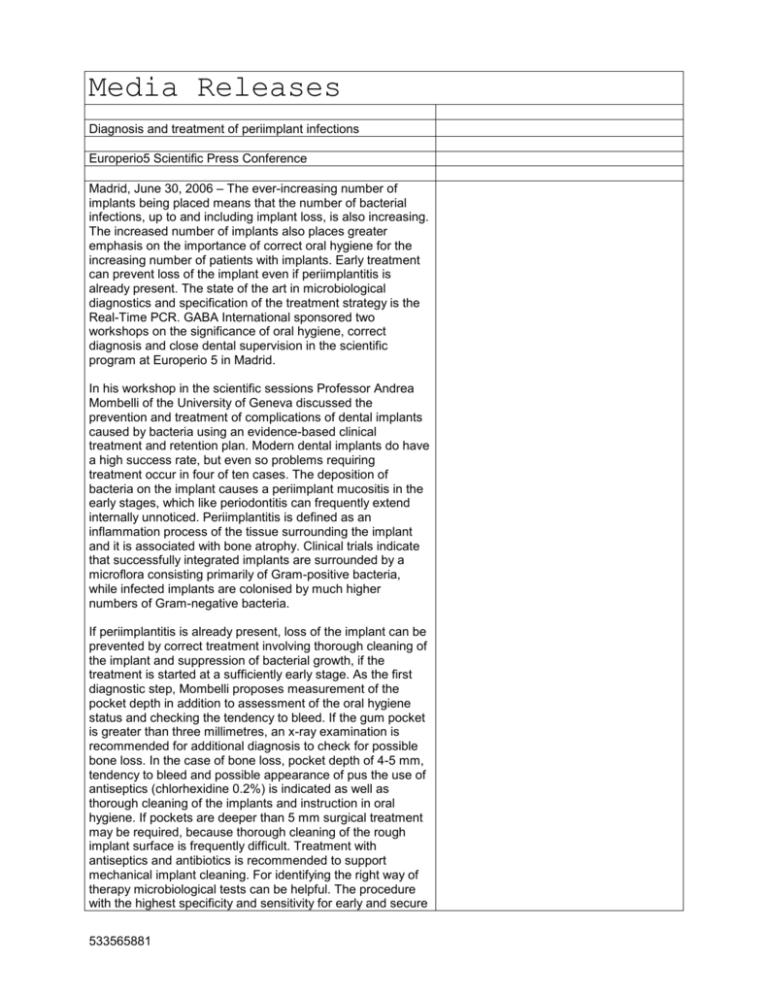
Media Releases Diagnosis and treatment of periimplant infections Europerio5 Scientific Press Conference Madrid, June 30, 2006 – The ever-increasing number of implants being placed means that the number of bacterial infections, up to and including implant loss, is also increasing. The increased number of implants also places greater emphasis on the importance of correct oral hygiene for the increasing number of patients with implants. Early treatment can prevent loss of the implant even if periimplantitis is already present. The state of the art in microbiological diagnostics and specification of the treatment strategy is the Real-Time PCR. GABA International sponsored two workshops on the significance of oral hygiene, correct diagnosis and close dental supervision in the scientific program at Europerio 5 in Madrid. In his workshop in the scientific sessions Professor Andrea Mombelli of the University of Geneva discussed the prevention and treatment of complications of dental implants caused by bacteria using an evidence-based clinical treatment and retention plan. Modern dental implants do have a high success rate, but even so problems requiring treatment occur in four of ten cases. The deposition of bacteria on the implant causes a periimplant mucositis in the early stages, which like periodontitis can frequently extend internally unnoticed. Periimplantitis is defined as an inflammation process of the tissue surrounding the implant and it is associated with bone atrophy. Clinical trials indicate that successfully integrated implants are surrounded by a microflora consisting primarily of Gram-positive bacteria, while infected implants are colonised by much higher numbers of Gram-negative bacteria. If periimplantitis is already present, loss of the implant can be prevented by correct treatment involving thorough cleaning of the implant and suppression of bacterial growth, if the treatment is started at a sufficiently early stage. As the first diagnostic step, Mombelli proposes measurement of the pocket depth in addition to assessment of the oral hygiene status and checking the tendency to bleed. If the gum pocket is greater than three millimetres, an x-ray examination is recommended for additional diagnosis to check for possible bone loss. In the case of bone loss, pocket depth of 4-5 mm, tendency to bleed and possible appearance of pus the use of antiseptics (chlorhexidine 0.2%) is indicated as well as thorough cleaning of the implants and instruction in oral hygiene. If pockets are deeper than 5 mm surgical treatment may be required, because thorough cleaning of the rough implant surface is frequently difficult. Treatment with antiseptics and antibiotics is recommended to support mechanical implant cleaning. For identifying the right way of therapy microbiological tests can be helpful. The procedure with the highest specificity and sensitivity for early and secure 533565881 diagnosis is the Real-Time PCR for quantitative detection of the six most important marker organisms for periimplantitis and the total bacterial count. Professor Søren Jepsen and Dr Pia-Merete Jervœ-Storm of the University of Bonn tested the sensitivity of various microbiological test procedures and presented their results at the Forum for Innovation at Europerio 5. They referred to meridol® Perio Diagnostics, whose technology is based on the Real-Time Polymerase Chain Reaction (Real-Time PCR), as the state of the art. Compared to methods using conventional culturing of bacteria, the Real-Time PCR does not require vital specimen material. This offers significant advantages in cases of periodontal pathogenic Gram-negative microbes, which require anaerobic conditions for growth. In the RealTime PCR method the specimens are tested for specific DNA sequences. The automated analysis can identify and quantify six periodontal pathogenic marker organisms (A. actinomycetemcomitans, P. gingivalis, T. forsythensis, F. nucleatum, P. intermedia, T. denticola). Quantification of the bacterial population in the subgingival plaque alone offers great advantages when it comes to making a decision on the treatment required. The Bonn scientists also presented the results of a comparative study on the clinical effects of full-mouth root planing (FMRP) compared to root planing of single quadrants (QRP). In the case of FMRP the test subjects received subgingival scaling and root planing in all quadrants in two sessions within 24 hours. In the case of QRP the scaling was conducted by quadrant at weekly intervals. No significant differences in the individual parameters and the entire mouth could be found for the parameters of pocket depth (PPD), bleeding index (BOP) and attachment loss (RAL). The two workshops presented by Prof. Mombelli (University of Geneva) and Prof. Jepsen and Dr. Jervœ-Storm (University of Bonn) were sponsored by GABA International at Europerio 5 in Madrid. Download Text: - *.doc - *.rtf Download Images: - Image 1: … - Image 2: … - Image 3: … Media Contact: GABA International AG Dr. Stefan Hartwig 533565881 Emil Frey-Strasse 100 4142 Münchenstein Switzerland Phone: +41 61 415 60 74 Fax: +41 61 415 60 00 E-Mail: info@gaba.com 533565881



